
May 2006
The Daley News
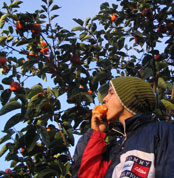 Autumn heralds the end of summer heat and humidity. It brings perfect days with clear blue skies, and cool nights. On the horticultural front it's an excellent time to get out in the orchard and prepare for winter. For me, it's a time to get the grass under control. After a summer with good rainfall, weeding and mulching are the main jobs in the autumnal orchard. For those of you who are in frost-prone areas it's a good time to prepare for these cold nights. Preparation includes putting posts in the ground to cover frost-sensitive plants.
Autumn heralds the end of summer heat and humidity. It brings perfect days with clear blue skies, and cool nights. On the horticultural front it's an excellent time to get out in the orchard and prepare for winter. For me, it's a time to get the grass under control. After a summer with good rainfall, weeding and mulching are the main jobs in the autumnal orchard. For those of you who are in frost-prone areas it's a good time to prepare for these cold nights. Preparation includes putting posts in the ground to cover frost-sensitive plants.
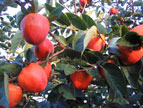 Here in the orchard at Daley's we have a feast of fruits tempting us. The carambolas are fat and delicious; we have a splendid crop of astringent persimmons which look like bright, giant decorations on laden trees. As well as Fuyu’s, the non-astringent type which are smaller but equally attractive. The feijoas are almost finished here and will just be starting to finish up in cooler climates. Custard apples are beginning to come off, chestnuts are falling, the Governors plums and kiwi fruits are cropping heavily this year. In other orchards, Rod has just finished harvesting his pecans which have produced a bumper crop for him this year due to the excellent season that we have been blessed with here in Kyogle. It also means his battle with the sulpher-crested cockatoo’s is over for another year.
Here in the orchard at Daley's we have a feast of fruits tempting us. The carambolas are fat and delicious; we have a splendid crop of astringent persimmons which look like bright, giant decorations on laden trees. As well as Fuyu’s, the non-astringent type which are smaller but equally attractive. The feijoas are almost finished here and will just be starting to finish up in cooler climates. Custard apples are beginning to come off, chestnuts are falling, the Governors plums and kiwi fruits are cropping heavily this year. In other orchards, Rod has just finished harvesting his pecans which have produced a bumper crop for him this year due to the excellent season that we have been blessed with here in Kyogle. It also means his battle with the sulpher-crested cockatoo’s is over for another year.
In other news, 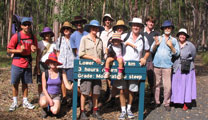 our bosses treated us all to a weekend away at the end of March near Mount Barney, where we explored the portholes and had a fantastic time. Thanks from all of us for that trip.
our bosses treated us all to a weekend away at the end of March near Mount Barney, where we explored the portholes and had a fantastic time. Thanks from all of us for that trip.
At the moment we are one down, with Katie, one of our propagation experts, travelling South America for four months. We look forward to her return, and her tales of tropical fruits and adventure which we'll bring to you in our spring newsletter.
Fruit Tree of the Month
Guiana Chestnut – Pachira aquatica
 The Guiana chestnut is one of our most stunning trees. It is a member of the bombax or baobab family and even from a very young age it has the tell-tale swollen trunk that is an endearing feature of this group of plants. It is closely related to the smaller but similar Malabah chestnut. The large buttressed root system holds the Guiana Chestnut to the banks of rivers and estuaries in its native environment in Mexico, Central and South America. It's a wetland tree where its branches can be seen arching out over the water. It reaches a height of
The Guiana chestnut is one of our most stunning trees. It is a member of the bombax or baobab family and even from a very young age it has the tell-tale swollen trunk that is an endearing feature of this group of plants. It is closely related to the smaller but similar Malabah chestnut. The large buttressed root system holds the Guiana Chestnut to the banks of rivers and estuaries in its native environment in Mexico, Central and South America. It's a wetland tree where its branches can be seen arching out over the water. It reaches a height of 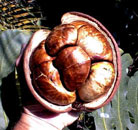 about 15 metres with a dense spreading crown. The stunning, fragrant flowers emerge from foot long buds, although they are usually almost hidden among the dense foliage. The Guiana chestnut can be grown in full or partial sun, it grows best if protected from drying winds and will respond well to additional deep watering, especially during dry times. They look fantastic in pots and will be happy as indoor plants if they are put outside when it is raining.
about 15 metres with a dense spreading crown. The stunning, fragrant flowers emerge from foot long buds, although they are usually almost hidden among the dense foliage. The Guiana chestnut can be grown in full or partial sun, it grows best if protected from drying winds and will respond well to additional deep watering, especially during dry times. They look fantastic in pots and will be happy as indoor plants if they are put outside when it is raining.
Bush Food of the Month
Walking Stick Palm – Linospadix monostachya
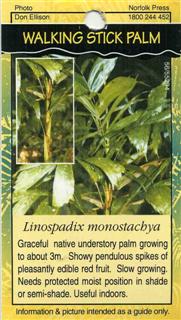 The Walking Stick Palm is a beautiful miniature palm, native to the rainforests of Northern NSW and Southern Queensland. It grows in the low -light conditions of the understory beneath a canopy of Bangalow palms and beside the notorious lawyer cane palm, where it seldom if never sees any direct sunlight. The microclimate under the rainforest canopy is cool and humid, even in mid-summer it seldom rises above 25 degrees and the humus rich soils never dries out.
The Walking Stick Palm is a beautiful miniature palm, native to the rainforests of Northern NSW and Southern Queensland. It grows in the low -light conditions of the understory beneath a canopy of Bangalow palms and beside the notorious lawyer cane palm, where it seldom if never sees any direct sunlight. The microclimate under the rainforest canopy is cool and humid, even in mid-summer it seldom rises above 25 degrees and the humus rich soils never dries out.
The wood of the walking stick palm is incredibly strong and durable - walking stick palms were used as walking sticks for returning injured Diggers at the end of World War 1. The dug palm had its roots removed; leaving a knobby ball which when sanded and polished made an excellent hand grip. The stem was cut to the desired length and a rubber button fitted to the end to create the stick.
The main drawback with this beautiful little palm is the speed at which it grows; in fact speed is not a word that is associated with the walking stick palm as they are very slow especially in their early stages. They do however suit potted culture and make ideal house plants due to their size and love of low-light conditions. Like all house plants they will respond beautifully to being put outside in the rain. They are fantastic landscaping plants for areas where there are good moisture levels and deep shade.
The small fruits that are produced in the warm summer months are edible, and sweet, and they make a great bush walking snack for those who are lucky enough to be exploring our beautiful rainforest of the east coast. In 1937 when the Stinson aircraft crashed in the wilds of Lamington National Park, the survivors Joe Binstead and John Proud survived for 10 days eating only the fruits of the walking stick palm that Binstead collected on his daily trip to the creek for water.
Rainforest Plant of the Month
Broad-Leaved Palm Lily – Cordyline petiolaris
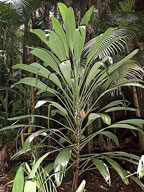 Cordylines are one of my all time favourite groups of plants and this variety is at the top of the list. The Broad-Leaved palm Lily is a large cordyline which can reach heights of 5m in the forest as it reaches for light, although it is more often seen as a 1-2 m plant. It is common in the sub-tropical rainforests of Northern NSW and Southern Queensland where it grows along with Cordyline rubra and Cordyline stricta. As plants mature they form multi-stemmed clumps with meter long, glossy green arching leaves they are beautiful to look at and are fantastic to use as a substitute for palms where height or moisture levels are a restriction. Broad leaved palm lily’s are exceptionally hardy but will look best if protected from direct hot sunlight which will burn the leaves and if given a little extra moisture in dry times. Palm Lily’s make excellent potted plants where they can be grown indoors or on patios, frogs love them and they are perfect for landscaping around pools and ponds where they give a tropical feel to the space. Spikes of tiny purple flowers are followed by edible, ornamental red fruits which last for several weeks.
Cordylines are one of my all time favourite groups of plants and this variety is at the top of the list. The Broad-Leaved palm Lily is a large cordyline which can reach heights of 5m in the forest as it reaches for light, although it is more often seen as a 1-2 m plant. It is common in the sub-tropical rainforests of Northern NSW and Southern Queensland where it grows along with Cordyline rubra and Cordyline stricta. As plants mature they form multi-stemmed clumps with meter long, glossy green arching leaves they are beautiful to look at and are fantastic to use as a substitute for palms where height or moisture levels are a restriction. Broad leaved palm lily’s are exceptionally hardy but will look best if protected from direct hot sunlight which will burn the leaves and if given a little extra moisture in dry times. Palm Lily’s make excellent potted plants where they can be grown indoors or on patios, frogs love them and they are perfect for landscaping around pools and ponds where they give a tropical feel to the space. Spikes of tiny purple flowers are followed by edible, ornamental red fruits which last for several weeks.
Combating Fruit Flies and Other Bugs
Fruit flies are one of the things we frequently get asked about. In the last couple of newsletters I have told you about Wild May and our fruit fly baiting program here at the nursery. This time I am going to introduce another couple of useful products for your home orchards. Both are certified organic.
eco-naturalure
 Eco-naturalure is a certified organic fruit fly control spray for both male and female flies. It combines specific foodbased attractants which target only fruit flies and a bacteria derived insecticide, spinosad. No withholding period. Controls both Queensland and Mediterranean fruit flies.
Eco-naturalure is a certified organic fruit fly control spray for both male and female flies. It combines specific foodbased attractants which target only fruit flies and a bacteria derived insecticide, spinosad. No withholding period. Controls both Queensland and Mediterranean fruit flies.
eco-oil
 Eco-oil is a certified organic miticide/insecticide spray made from Australian grown canola oil, enhanced with a blend of tea tree and eucalyptus oils. It controls a broad range of insects including scale, mites, aphids, whitefly and leafminer. There is less risk of burning foliage than with traditional mineral oil sprays and no withholding periods on edible crops.
Eco-oil is a certified organic miticide/insecticide spray made from Australian grown canola oil, enhanced with a blend of tea tree and eucalyptus oils. It controls a broad range of insects including scale, mites, aphids, whitefly and leafminer. There is less risk of burning foliage than with traditional mineral oil sprays and no withholding periods on edible crops.





